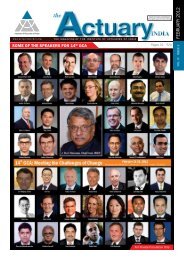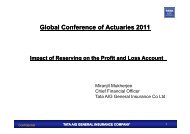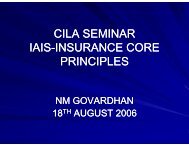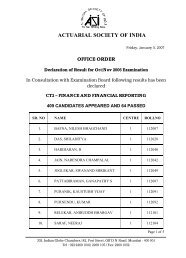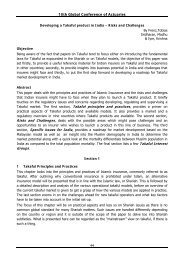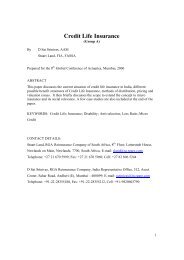January - Actuarial Society of India
January - Actuarial Society of India
January - Actuarial Society of India
You also want an ePaper? Increase the reach of your titles
YUMPU automatically turns print PDFs into web optimized ePapers that Google loves.
FEATURES<br />
Determining value <strong>of</strong> the Integral<br />
deterministically:<br />
Say, we have a y=f(x)=x 2 function we<br />
want to evaluate the integralf(x)dx<br />
with an upper bound <strong>of</strong> 5 and a lower<br />
bound <strong>of</strong> 0. That is, we want to evaluate<br />
the integral: 0<br />
I= x2 dx<br />
2<br />
When you nd the value <strong>of</strong> an integral,<br />
you are essentially nding the area<br />
under the curve traced by the function.<br />
In the above case, the integral I gives<br />
the area under the curve in a XY plane<br />
given by y=f(x)=x 2 in the domain [0, 5].<br />
Another way <strong>of</strong> looking at an integral is to<br />
think <strong>of</strong> it as an average value. Finding<br />
an integral is like averaging over the<br />
function in that domain. The area under<br />
such a curve can be approximated by the<br />
function A where<br />
The value <strong>of</strong> the above integral can be<br />
found out using the mean value theorem.<br />
Determining the value <strong>of</strong> the integral<br />
stochastically:<br />
Consider the above integral. raw a<br />
random variable h in the interval [a, b],<br />
i.e. h [a,b], where a is the lower bound<br />
<strong>of</strong> the integral and b is the upper bound<br />
<strong>of</strong> the integral. The curve starts from a<br />
(on the axis and ends at b (again, on the<br />
axis. In our example here a is 0 and b is 5.<br />
Note that the random variable h is drawn<br />
from a known probability distribution<br />
(such as uniform or Gaussian which<br />
has a known density function Ø(.. Then<br />
if we consider the estimator the<br />
“expected value <strong>of</strong> the integral can be<br />
represented as:<br />
As we see, the problem has now become<br />
stochastic (random but tractable<br />
because we can sample from a known<br />
probability distribution and estimate the<br />
value, even though that would not be<br />
an exact value. The estimator μ helps<br />
in preserving the sampling probability<br />
distribution. Here, without knowing<br />
anything about the analytical behavior <strong>of</strong><br />
the function f (x we are able to evaluate<br />
the integral, and nd the area<br />
under the curve. This is the essence <strong>of</strong><br />
onte Carlo Integration.<br />
C integration is a special case <strong>of</strong><br />
Importance Sampling, which we shall<br />
see later.<br />
MONTE ARLO INTEGRATION PART II<br />
Part 1 <strong>of</strong> this article has beem published in Actuary <strong>India</strong> December Issue<br />
An easy example would be to be compute<br />
the area under the standard normal<br />
curve between 0 and 1.<br />
The integral would be <strong>of</strong> the form.<br />
If we use the standard normal tables this<br />
value should be 0.34145.<br />
Here is a code to calculate the value<br />
using C integration in Visual Basic in<br />
Excel.<br />
Sub montecarlo_int_gauss()<br />
Dim counter As Integer, i As Double,<br />
j As Double, total As Double, z As<br />
Double<br />
counter = 0<br />
For counter = 1 To 1000<br />
i = Rnd()<br />
z = Exp((-i ^ 2) / 2)<br />
total = total + z<br />
Next counterd<br />
ActiveCell.Value = (total / counter) /<br />
(2 * Application.WorksheetFunction.<br />
Pi()) ^ 0.5<br />
End Sub<br />
Below are the tabulated values for<br />
different number <strong>of</strong> runs <strong>of</strong> random<br />
numbers and its closeness to the actual<br />
values.<br />
No. <strong>of</strong> random<br />
number generated<br />
What we have essentially done above is<br />
randomly generate numbers within the<br />
given limits (0,1 using a uniform (0,1,<br />
evaluated the value <strong>of</strong> the function at<br />
each <strong>of</strong> the discrete points, summed up<br />
the values <strong>of</strong> the function and divided by<br />
the size <strong>of</strong> the interval i.e. the number <strong>of</strong><br />
random points generated.<br />
What are the benets <strong>of</strong> onte Carlo<br />
(C (or Stochastic Integration over<br />
other Numerical ethods:<br />
1. This method is easy to implement.<br />
There are only minimal requirements<br />
that make the method applicable to<br />
very difcult integration problems.<br />
The evaluation requires only the<br />
ability to sample random points x<br />
and evaluate f(x for these points.<br />
2. The standard error does not depend<br />
upon the dimensionality <strong>of</strong> the<br />
integral whereas most techniques<br />
.<br />
Tabulated<br />
Values<br />
About the Author<br />
aseem.kumtagmail.com<br />
by Aseem umta<br />
Aseem umta is a Student member <strong>of</strong><br />
the Institute <strong>of</strong> Actuaries <strong>of</strong> <strong>India</strong>. He is<br />
currently working in RGA SIPL.<br />
<strong>of</strong> numerical integration—such as<br />
the trapezoidal rule or Simpson’s<br />
method—suffer from the curse <strong>of</strong><br />
dimensionality.<br />
3. One <strong>of</strong> the key features <strong>of</strong> the<br />
C Integration is that in higher<br />
dimensions one need not generate<br />
points from each dimension to<br />
evaluate the answer which makes<br />
it so different from other numerical<br />
integration techniques such as the<br />
Simpson’s rules or the Gaussian<br />
Quadrature i.e. for dimensions<br />
we would only need ‘n’ random<br />
numbers using C method whereas<br />
other numerical methods would<br />
require n random numbers.<br />
10 100 1000 10000<br />
Values 0.3413444 0.2111 0.33502 0.3302 0.34214<br />
eviation<br />
5.2 .1 .32 100.23<br />
from table<br />
However this method suffers from its<br />
own limitations such as:<br />
1. It must be decided in advance on the<br />
number <strong>of</strong> points we plan to choose.<br />
Once the number <strong>of</strong> random points<br />
are chosen all those sample points<br />
should be completing. With a grid it<br />
is not convenient to “sample until<br />
convergence or termination criteria<br />
are met.<br />
2. The C method converges slowly.<br />
The convergence rate —how quickly<br />
the error decreases with the number<br />
<strong>of</strong> samples—<strong>of</strong> basic onte Carlo<br />
integration is proportional to 1/<br />
sqrt(N. This means that to halve the<br />
error, four times as many samples<br />
are needed.<br />
3. The error bound does not reect<br />
any additional regularity <strong>of</strong> the<br />
integrand.<br />
18 The Actuary <strong>India</strong>



